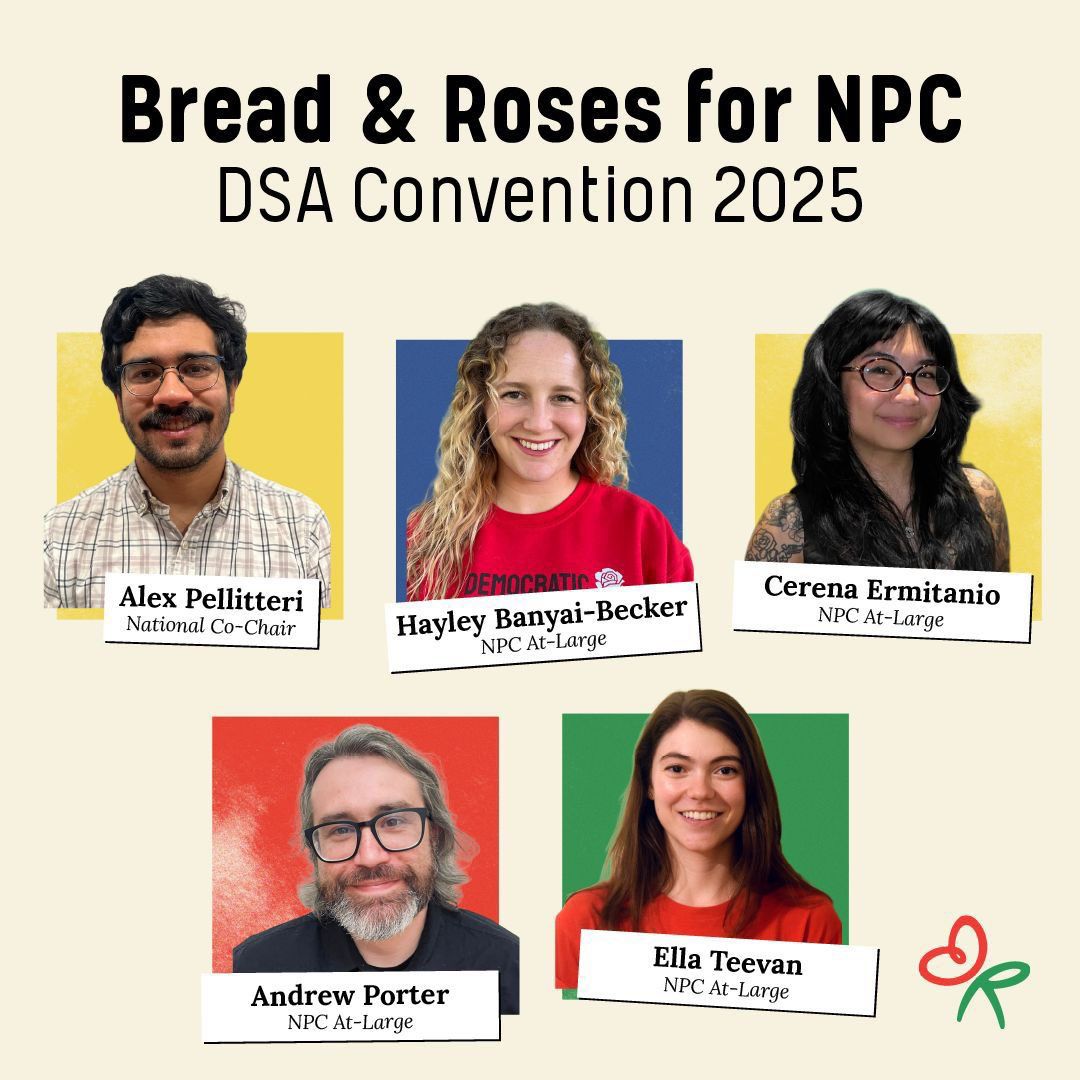Twenty twenty three could be a big year for the working class. Union contracts are up for more than 1.6 million workers. There could be major national strikes at UPS and the Big Three automakers, while other high-profile fights are brewing in core industries like logistics, healthcare, and transport. And crucially, this year could make or break the inspiring Starbucks Workers United (SBWU) drive, as well as the mini-wave of new organizing at Amazon, Trader Joe’s, and other giant retailers.
These are historic opportunities to build working-class organization and power, making 2023 a critical year for the socialist movement. But there’s another reason for socialists to look forward to the coming year: this August, the Democratic Socialists of America (DSA) — the largest U.S. socialist organization in a century — is holding its 22nd national convention.
DSA has fragile but hugely important links to the resurgent labor movement. Our members have played crucial roles in the uptick of class struggle over the past few years. But our boom period is cooling, and we still face major obstacles to broadening our activities and deepening our connection to the working class.
DSA won’t just stumble into serious political engagement or deep internal strategy debates. It is up to DSA’s active layer to force the most important questions: Where does DSA stand? How did we get here? And how can we leverage the coming year and convention to build our organization and the socialist movement?
Hard Times for DSA
It’s no secret that DSA has hit a rough patch. We are losing members for the first time in years: 12,000 since August 2021, according to figures leaked by Jenbo, a member of the National Political Committee (NPC). The percentage of members with lapsed dues is rising. Chapters are experiencing widespread disengagement and burnout, something national staff noted in their report to the 2021 convention. A sense of malaise is afflicting the entire organization, from national committees to local working groups.
These struggles stem, in part, from shifts in national politics well out of our control. The pandemic decimated DSA’s political life (and everything else). The Biden administration’s start-again, stop-again reformism has co-opted most of the energy behind reforms like the Green New Deal and Medicare for All. Most importantly, the two major spurs to DSA’s growth — the Bernie campaigns and the Trump presidency — are gone, and we haven’t found a way to replicate the sense of purpose and urgency they both provided.
But we can’t lay the blame entirely on outside factors. Repeated crises of leadership under the current NPC haven’t helped. There have been highly public spats over elected accountability, first the Bowman affair and then the rail TA controversy; a lack of transparency from the NPC majority around issues like staff hires and list work that should be public knowledge in a democratic organization; and a general lack of political leadership from DSA’s elected and unelected top officials, on issues as different as Ukraine and environmental politics.
These issues are informed by the deep, long-term structural problems facing DSA. These deserve an article of their own, but they include a wide open membership structure, a heavy reliance on passive internet recruitment, underresourced staff, decentralized chapters, and a dysfunctional national committee structure.
The flip side of a bad situation, however, is that there’s plenty of work to do to get DSA moving in a better direction. The national convention, and the conversations we can have in the run-up, are our opportunity to decide this direction.
The 2023 Convention: Charting a New Path
National convention is DSA’s highest decision-making body. This year more than ever, it is crucial to have a political, democratic convention — something we have struggled to achieve in the three conventions since the 2016 revival of the organization.
The problems are widely recognized. Past conventions have been marred by intense proceduralism and bitter interpersonal conflicts. Far too many resolutions are passed to set meaningful national priorities, and there is never enough political debate for delegates to be able to choose between them, giving staff and the next NPC the real power to set DSA’s political direction.
Still, whether we like it or not, convention will set the framework of our organizing for the next two years. So we should approach this year’s convention with three main focuses:
- Developing a concrete program,
- Passing badly needed structural reforms, and
- Debating the burning political issues that have cropped up over the last few years.
Drafting a program
A program is like a political roadmap. It lays out a group’s major short-term and long-term goals. It identifies the obstacles to achieving those goals, and makes concrete suggestions for how to overcome them. Most importantly, a program offers an analysis of the political moment, and names the priorities that will allow the group to most effectively intervene in that moment.
DSA doesn’t have a program. Every convention, we debate and vote on dozens of resolutions, which have little connection to each other and, since they mostly exceed our budget, are hardly ever implemented as written. The NPC and staff are forced to set a few national priorities by picking and choosing among the resolutions convention passes. This only feeds into the cynicism and disconnection many members feel toward national DSA.
But things might be different this time around. The NPC has decided to raise the number of signatures needed to bring independent resolutions to the floor. Most resolutions will be “consensus proposals from priority national bodies,” in the words of the convention plan passed by the NPC in August. Political differences will come out of the amendments to these proposals. By trimming the number of resolutions and sharpening the focus on a few key national priorities, this new process could move us away from long wishlists of disconnected resolutions and toward a coherent program.
But what would a program for DSA even look like? Ultimately, of course, that’s for delegates to decide, but as we start to debate the question, we should keep two facts about the political situation firmly in our mind.
First, there are unmistakable signs of a revival in the labor movement. In just the last few years, there have been major upheavals in education, healthcare, logistics, auto, rail, and other strategic industries. The machines that control the big international unions have proven brittle to the point of crumbling in the face of rank-and-file reform movements. The unorganized majority of workers are taking their first tentative steps toward a real upsurge. We should keep our eyes open, but it’s hard to deny how promising this all is.
Second, the Democratic Party has shown itself more and more willing to discard basic commitments to the working class. The gutting of every piece of social legislation proposed by the Biden administration was an early sign of this. But the climax came in the recent rail negotiations, when the Democrats, jittery at even the hint of a national rail strike, imposed a contract on tens of thousands of workers against their expressed democratic will. The open contempt for workers — especially in the context of high inflation and a looming recession — is striking.
Our strategy should conform to those two crucial facts by keeping a laser focus on our two most powerful weapons: rank-and-file labor organizing that roots us in the most militant sections of the working class, and the kind of independent, class struggle elections that can build a real political alternative to the Democrats.
Concretely, in labor, we should officially re-adopt the rank-and-file strategy. We did so at our last two conventions, but we’ve struggled to back up those paper commitments with real resources. We need to root ourselves in the working class for the long haul, building shop floor organization and winning working-class leaders to the socialist movement. The rank-and-file strategy is the way to do it.
We should build on the work done by our National Labor Commission (NLC) in systematically identifying organizers who are willing to take strategic rank-and-file jobs, a crucial tactic the strategy employs. And we should keep experimenting with local industry groups or “fractions”: groups of socialist and militant workers in the same industry or union who meet regularly to share lessons and plan strategy. Despite their problems (low turnout, lack of projects) these formations have huge potential to build solid, locally rooted groups of class-conscious workers in core industries, on the model of the Communist Party’s old “fractions.”
DSA Labor is also running a number of national campaigns, especially Organize Logistics — which focuses on connecting DSA workers in the logistics industry — and the Labor Corps, a new project to systematize DSA’s inspiring strike solidarity work. If we are willing to put real staff and financial resources into these campaigns, we could build large-scale organic links between DSA and the (mostly non-DSA) workers leading the current wave of collective struggle at Amazon, Starbucks and beyond.
In terms of electoral work, the highest priority is to recommit to building an independent, working-class alternative to the Democrats. The best way to do that is by building on promising pre-party efforts like the New York Socialists in Office (SIO), the Chicago Socialist Caucus, and the Richmond Progressive Alliance (RPA). Chapters should be encouraged — and supported — to draft coordinated local electoral plans, like the recent 1-2-3-4 Plan brought to the NYC-DSA convention.
A large, functional National Electoral Committee (NEC), rooted in the work of local chapters and able to share funds and strategic advice widely, will be key. A plan for the NEC could be modeled after the recent successes of DSA Labor, which has transformed itself into a functional, democratic membership body in just a few months. This convention could even see the founding of a National Electoral Commission, a membership body with the volunteer power and democratic mandate to carry out a real national electoral strategy.
Above all, we should be systematically connecting our electoral and labor work, pairing the technical skill and volunteer power of DSA with the financial resources and structural power of unions. Elected officials can’t just legislate socialism from on high; they need the power and pressure of a militant, organized working class to truly transform society.
There are other important aspects to a program: recruiting more working class and people of color to DSA, commiting to deeper political education, and many others. But labor and electoral — rank-and-file power and party-building — should be the two pillars of our strategy going forward. They are the only forms of organizing that can build large-scale power on a tight timescale, and activate tens or hundreds of thousands of members, supporters and recruits.
Reforming DSA
Only a real program, developed through robust democratic debate, can unite us as an organization and allow us to effectively intervene in the very promising political situation this year. But a program should be paired with the kind of structural reforms that DSA — an organization that grew from 6,000 to 90,000 members in just a few years — desperately needs.
Any number of reforms could improve the situation, but we must recognize the core of the problem: our elected national leadership are volunteers who, even with part-time stipends, don’t have the time or resources to truly lead the organization, leaving most of the real political power in the hands of (unelected) senior staff and the national director.
To address this problem, we need to build on the positive steps from past conventions and provide full, not part-time, stipends to the NPC Steering Committee, as well as part-time stipends to other NPC members, YDSA’s National Coordinating Committee, and the Steering Committees of our national committees. Our elected leaders shouldn’t be forced to slog through their terms basically working two full-time jobs. They need time and freedom from other work to truly implement the organization’s program.
Other proposals have been floated, like electing our national director (which failed to pass at the 2021 convention) and referendum and recall (ditto). The idea of expanding the NPC — a 16-person body which is supposed to represent almost 100,000 members — has been in the air for some time. Any ideas for reform should be seriously considered in the run-up to convention. But the central political problem that needs solving is how to empower DSA’s democratically elected leadership to actually carry out the tasks delegates decide to give them.
Debating the future
Many DSA members are familiar with the two major crises of the last few years: the Bowman affair in 2021, and last year’s controversy over the rail workers’ contract. The Bowman affair exploded into an ugly power struggle between the NPC and the national BDS Working Group. The rail TA issue didn’t escalate that far, but similarly, it sapped trust in DSA’s principles and poisoned many members’ views of national leadership.
At the heart of both crises is a political issue — should DSA members of Congress be held to a program, or at least some basic standards of behavior? If so, how? What should the relationship between DSA and DSA electeds look like?
Because these are political issues, the only way to truly resolve them is to pose the questions to convention — not to the NPC, not to any of our national committees, but to the highest political body in DSA. At least one plenary, and maybe some additional debate time, should be set aside at convention to discuss the accountability issue, which has caused such intense conflict. DSA congresspeople should be invited to speak and defend their positions. Emotions will certainly be running high, but delegates should be trusted to debate the issue in a comradely way.
At the end of the process — even if some DSA members won’t like this — delegates should be presented with options for disciplining members of the Squad, from censure all the way up to expulsion. Even if a member is (like me) personally against expulsion, they should be able to respect a democratic process, and agree that only convention can give the final word on the controversies of the last few years. It is the only way to avoid similar wildfires from breaking out again in the near future.
Decline or Rebuild?
It’s up to us whether this year will be a time of consolidation and strengthening, or disarray and decline. Convention is the key. We should start organizing for it now, locally and nationally: putting on forums and debates on the big political issues, forming delegate slates, writing resolutions and position pieces to drive debate.
DSA is centrally important to the project of reviving mass socialist politics, and merging it with a militant, democratic labor movement. This year we have the chance to build the big, powerful socialist organization we all dream about. We should take it.




